Walking the suburban margins of London I have stumbled - sometimes with surprise - across a range of housing estates. The explosion in population in the outer reaches of the capital travelled through the 20th century like a shockwave. Propelled by changing economic conditions, the aftermath of two long and bruising wars and the recognition that the conditions of life many faced were appaling, these new enclaves grew swiftly in every corner of the metropolis. The schemes varied in size, in style and in ambition - from the modest in-fill blocks of 1930s balcony flats to the vast sweep of Becontree - but had one thing in common: a recognition by the agents of the state that only intervention in the housing conditions of a mass of Londoners could assure they were adequately met. On paper at least, John Boughton's tale of council housing - a term he very deliberately sticks to throughout the work - shouldn't be an exciting read. However, the progress through a turbulent century where municipalism meets modernism is compelling from the early philanthropic green shoots right up to the present where ideology finally appears to triumph.
Born out of a painstakingly well-researched blog, Municipal Dreams makes the leap from screen to page effortlessly: Boughton sifts detail effortlessly, weaving the stories of some of the key people driving the rise of council housing into the broader narrative of policy directions and architectural bravado. A range of responses to the growing need in the early part of the century is explored, from the bravely modern adopters of Corbusier's vision to those Boroughs who dabbled in the building of garden suburbs. The book is anchored in London - which was a focus of the most intense need and the most varied solutions - but doesn't exclude the work of ambitious authorities in Liverpool, Birmingham, Newcastle and beyond. Throughout, the voices of tenants are given the space they didn't get in those days before consultation was a mandatory tick-box on the decision, and the book is peppered with contemporary quotes and interviews with those who experienced the shift from slum to point block.
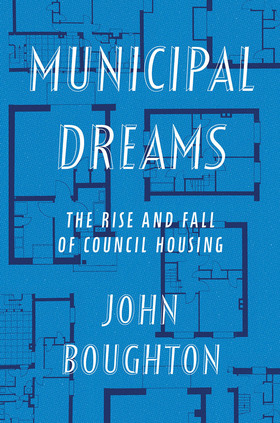
I came to this book most interested perhaps in the architectural history: and Boughton doesn't disappoint in his exploration of the rise and - tragically literal - fall of system-building, the debates about densification and the ultimate rejection of modernism. However, the book is necessarily political too - and achieves a rare balance. The simple fact, as Boughton exposes very ably, is that both left and right tackled the issue of housing via intervention and that while the positions were not widely variant at the outset, the voices of ideologues have dominated the more recent discourse. Two distinct shifts in thinking emerged as the century entered its second half: the left shifting from a broad universalism to a rhetoric of 'greatest need' while the right responded by lionizing the aspiration to escape the clutches of the state. As the new century opened and local authorities grappled with the best means to leverage capital from the private sector, these views have whirled together into a perfect storm of policy failure: there is simply not enough housing, and no agreement on how that is best remedied. Boughton's book explores both the creation and the outcomes of this dilemma with care and precision - no party is let off the hook, as the dizzying and contradictory tumble of Housing Acts endlessly rebadges but fails to increase existing investment, indulges in ill-advised tinkering and ultimately presents the same old tricks in new clothes. Council housing becomes contested, blamed, a diagnosis rather than a symptom as a result. Residualisation both creates the myth of the 'sink estate' and condemns some troubled places needing assistance to perhaps even deep opprobrium.
Council housing is a political issue - and if you approach this book from an extreme in either direction - as a radical Corbyn supporter seeking an endorsement of the state as guardian of the people, or as a steamrollering free-marketeer who wants the dubiously proven laws of economics to take the decisions out of our hands - you will be disappointed. Boughton's book is a plea to the kind of municipal collaboration and effort which dominated the discourse back when those who governed Britain shared a collective will to solve problems and when politicians could disagree across the house - and indeed along their own benches - without resorting to character assassination. The post-war consensus which endured for many decades is after all, still active in the minds of the majority of voters, and perhaps it is only in those radical fringe voices - often thought the very loudest - that we have moved so far from this. It is a strange world where 'centrist' with is an insult. Boughton concludes that the state is good at some things and not at others and that the challenge is to restore the role of council housing: something that is simply one of those good things with a host of proven benefits and demonstrable value. The book opens and closes with a vision of Grenfell Tower smoldering and glowering over the rooftops of West London. At the outset, it appears a totem of failure, but by the end, it stands as a symbol of hope: good can be done, if we can separate lofty ideology and basic needs.
Throughout this journey - which is often frustrating and sad - Boughton manages to tell the complex, nuanced story with style and balance. It's easy to take sides - to believe that one path was more morally correct than another - but the public servants Boughton describes are usually, at least, doing their utmost with what they have and making decisions based on their best ideas. That they fell short is an inevitable conclusion to this concise but engaging history of an often glossed-over topic. John Boughton's book will likely become a standard text for those trying to understand this curious and torrid period as Britain accelerated to modernity, and then came to an abrupt halt.
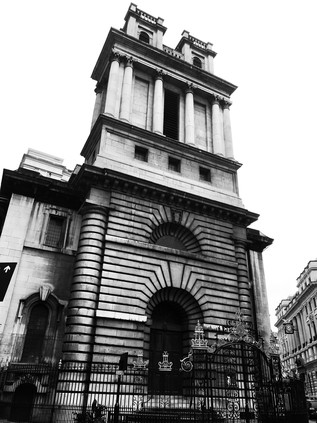
The Rust of Obscurity: An unexpected memory walk
Posted in London on Saturday 1st December 2018 at 10:12pm
After the relative return to normal service last month, things didn't look so good for today's excursion. The weather, doubtful all week, had closed in over the last day or so, leaving a high chance of heavy rain. I'd finally found time to plan some potential routes, but all of them would involve a degree of walking off-the-path, and it wasn't an encouraging prospect after a wet week. I set off intending to come up with some ideas during the journey - but even that appeared to be complicated: the incoming train to form my London-bound service was heavily delayed - an already later-than-usual arrival due to the timetable changes would be compounded by this delay. Winter walks over the years have been wildly variable, from long wet slogs to surprisingly brisk and bright treks - but I was tempted to give up right away on this one. I didn't though, for a number of reasons - mainly because I didn't know when I'd get to do this again. These monthly jaunts have become part of my routine - part of my prescription some have suggested. But due to some changes happening here, they're going to have to pause for some time. So, I couldn't abandon the last of these walks before it had begun. On arrival at Paddington, a glance out of the station wasn't edifying: a sea of umbrellas and miserable faces trudged onto the station concourse. I decided to take the Circle Line to Liverpool Street and reassess things there. With warm coffee in hand, things seemed more optimistic, so I figured I had nothing to lose and boarded a train out to Seven Kings. My reasoning was simple: on the last occasion a walk had been affected by weather, it was there I'd finally given in. If I arrived and didn't feel the same way today, I'd start walking west along the route I'd meant to follow. I'd see how far I got before the weather overcame my resolve...
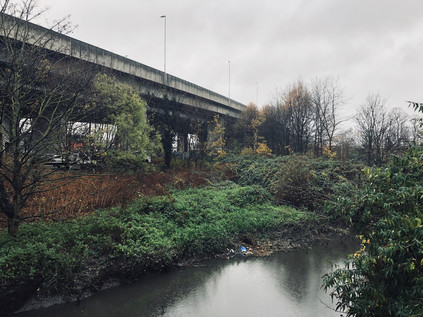
The first stretch of road was the test... Disappearing into the middle-distance under a featureless grey sky, the long straight path ahead funnelled traffic between the remains of a once fairly substantial High Road and a string of development sites: new housing appearing between the road and the fan of railway sidings which led into Ilford Depot. Through the gaps in the building site I spied a Class 08 shunter sitting beside the shed, off-duty and looking incongruously old-fashioned among the modern trains. Seven Kings deferred to Ilford - the main drag relegated to second-string shops and lesser-regarded supermarkets. The arrival of Ilford proper was heralded by jagged and shiny towers of housing rising on both sides of the street, and the soaring overpass carrying the tiny but A-road classified Griggs Approach over my head. Underneath, the mercifully dry voids in the bridge were stuffed with the belongings of resident homeless people, who had set off into the damp, near-deserted streets on the eastern edge of town in search of donations. There were few to be had this morning it appeared, and Ilford was a sorry sight in the rain with only its most desperate denizens strolling unsteadily between pub and bookies. A stumbling man reeking of cider shoulder-barged me accidentally in the otherwise empty broad pedestrian plaza and then undertook to offer a sarcastically over-stated apology. He appeared to be daring me to react, to give him some sort of human response - even if it was a punch on the nose I suspect he'd have been grateful. Across the street, outside the impressive sandstone pile of Redbridge Town Hall another man knelt on the pavement, head and arms curled under him in the foetal position. Passers-by navigated between him and the metal railings like he was an inconvenient pile of animal excrement. He made no sounds and didn't react. It was a sobering and almost impossibly miserable passage through a town which otherwise appeared to have all the facilities and features of a bustling, decent-sized centre. I'd been here numerous times before, but I'd never seen this face of Ilford.
I wasn't sorry to find myself near the corner of Ilford Hill where the station entrance bustled with activity. The rain had begun to fall now and I raised the hood of my jacket, wondering if this was the beginning of the end of my walk after all? A small, Asian woman bustled by with a partly-broken umbrella adorned with the name of a small hotel in the City which my wife and I had stayed in on her first visit to the UK years ago. Already soaked, she appeared to find more effective shelter under the sliproads of the North Circular, abandoning the umbrella in the palings of a fence which shielded the River Roding from the worst litter and filth discarded from the road above. This junction was redolent with memory for me - from both my long, sore-footed trudge along the North Circular, and the dash out of a summer storm while walking along the Roding. I spotted the telephone kiosk in which I'd sheltered during that sudden cloudburst, near the footpath which led under the railway towards the Aldersbrook. For the first time perhaps, the reality of my situation settled on my mind: I'd not be doing these walks for the foreseeable future. The city would continue without me - changing wildly, yet staying stubbornly the same in other aspects - but these corners would be memory anchors during my absence. Places fixed in my mental map which had the potential to link me directly back to a moment, insignificant to most but personally formative. I realised as I regarded a damp telephone box in the rain that this was going to be a walk linking unexpected memories...
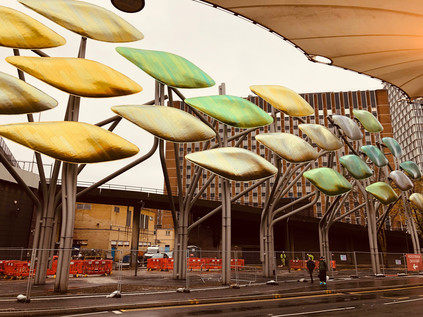
The stretch of Romford Road between Ilford and Stratford though, was new to me. I'd wondered when I set out from Brentwood on my previous attempt, whether I'd get this far along the ancient Roman route towards the Old Ford? I had assumed that Stratford might be where I ended that walk. In the event, curtailing the trek early meant I didn't have to think of a suitable ending - and I was in much the same position now. The rain had mostly stopped though the air was damp and heavy. I tentatively lowered my hood, pulled my cap on tight against the wind and strode onwards. It felt good to be walking after all the doubt and worry about the trip. The sky was a churn of grey and white, with no sign of a break in the clouds assuring that I was aware that this was a limited opportunity, a chance which could be curtailed at any turn by the weather. Entering Forest Gate, I was surprised by the continued dereliction. I'd found myself a little to the north of this spot, near the station, recently and it was generally a little tidier - there was a sense that the area was cared for and looked after to some extent. But here on the old road, it was shuttered-business-as-usual. I dodged and weaved, avoiding the deepest curbside puddles to prevent errant bus drivers from spraying me, and pushed onwards into Stratford, passing the fine brick and stone, domed buildings of the former Passmore Edwards Museum. Beginning life as the collection of the Essex Field Club, the building dates from 1900 when the West Ham Technical Institute was extended and generously decorated with Arts and Crafts style carvings representing the virtues of culture. At the same time, the complex was named for benefactor John Passmore Edwards: a newspaper magnate, Liberal politician and philanthropist who had donated generously to the cause of this and many other educational institutions. The museum bore his name until its closure in 1994. The collection was dispersed into Newham's various collections and museums - but sadly, mostly into non-public storage - and the building eventually became the Student Union for the University of East London. It is perhaps tempting to imagine what would have happened had the museum scraped into the early 21st century and been around for the Olympic regeneration of Stratford. Instead it folded during the cold storm of austerity in Local Government which drifted in with the recession. Stratford back then was painted as a grey, gloomy place which couldn't imagine a future - let alone the one it was destined to inherit. The road opened out into the Broadway, a new traffic scheme still confusing pedestrians and drivers alike. I dodged buses and cyclists, crossing the wide new plaza created between the arms of busy roads which converged on the former civic centre of the area. The focus had gradually drifted north - away from the rank of stately municipal buildings on the south side of the street to the Stratford Centre - a large regional shopping nexus built in 1974 and extended in 1998 but now dwarfed by the utterly vast Westfield complex beyond the station. Knotted into the curving service roads and stacks of concrete flats around the centre was Joan Littlewood's Theatre Royal, where the traditional brick facade seemed shockingly visible along the broad and busy mall. There was still a huge traffic of people through the complex - but the retail offer had stepped down a grade in deference to the dominance of Westfield's brand-names and braggadocio. A market struggled for much of the length of the West Mall, along which I diverted to access the facilities. As ever, I felt like everyone was walking in the opposite direction, jostling and shoving their way to early festive bargains and cheap shoes. I swerved around prams, careered into dawdling children and generally nuisanced my way through the centre, emerging opposite the station in a confusing churn of humanity. Ahead of me, a sweeping staircase funnelled people over the rust-brown iron bridge and into Westfield. Buses jostled and shunted in the newly reconfigured bus station, and people meandered across the concourse in front of the station, mostly absorbed in their screens - faces uplit by blue light in the grey afternoon. I'd been visiting Stratford for years now, watching it mutate as the station grew and changed, as Westfield arrived, as the Olympic Park dominated the landscape - and now, as it settled into its post Games status as a new eastern city centre. New buildings climbed their scaffolding cores on every horizon, the older towers of the Carpenters Estate looking small and timid against the jagged, gleaming lines of the new skyscrapers. The low-rise industrial landscape which had knitted into the brackish streams and power-lines of the Lea Valley was disappearing slowly, only stubborn and derelict outposts remaining. Stratford was a reminder that whenever I left London, it carried on without me - and would probably carry on without any of us. Driven by foreign capital and remote interests. It was possible to imagine a London without people at all, an engine of pure commerce and property speculation.
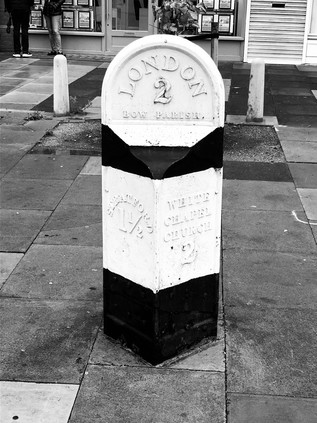
The road beyond Stratford was well-known, and I'd watched it change over the years. Beyond the familiar corner facade of The Builders Arms, appropriately the developers again held sway. The flanks of the road had been progressively cleared of their streetscape: redundant tyre dealerships swept away to be replaced by tall apartment blocks with ground-level gyms and integrated Tesco Metro stores. Up ahead, the vast sweep of industry around Sugarhouse Lane had been flattened into piles of indistinct grey pebbles and a new district was emerging slowly to fill the island site. The wooden hoardings made promises that their artists would never have to deliver on, and even a damp morning hadn't quite quelled the drifting dust from the demolition works. I crossed the Greenway finding its northern entrance closed - in fact, I couldn't remember a time when this path along the Northern Outfall Sewer had been wholly open since the announcement that the Olympics were coming to London. For a while in 2012 a temporary bridge had straddled the road here, ferrying ticket-holders from West Ham station towards the Olympic Park. Now a windswept Pelican crossing held sway, the button rarely needing to be pushed. Finding the remains of Blaker Road I turned aside and climbed down a steep flight of stairs to reach the towpath alongside the Bow Back River. I was again assailed by memory: of a walk which had confounded and intrigued me - an exploration of the contaminated zone between railway and street which had always seemed off-limits. It's fair to say, perhaps, that it was this excursion which kicked off this long trail out of London and back again. The riverside scene today was much altered, but couldn't be wholly tidied. All the new developments of Bow couldn't block out the messy, confused tangle of light industry which clung to Cook's Road for life. These backstreet bodyshops and recycling yards hadn't altered in years. They struggled on, dwarfed by towers of grey glass which were too high for residents to care much about their neighbouring ground-level eyesores since the lower floors of their flats had been given over to empty gyms and stations for bored concierges. Perhaps the collapsing sheds were marketed as a bit of real East End colour? The only hue which stood out from the dull shanty-town of workshops was regulation hi-vis green, reflected in the deeper mossy sheet of the river water. I rejoined the High Street as it approached the Bow Flyover, the shadowy missile-tower of the former Bryant and May factory dominating the horizon beyond the grimy tunnel of the A12 passing below. I'd been here just a short while ago and it felt rather comforting to be back again so soon. I realised as I passed through this well-trodden zone, far from home but curiously imbued with a sense of belonging and safety, that I'd probably not be back for a while now. It had never seemed important before, this beleaguered roadside spot nestled between an ancient church and a modern McDonalds was after all, nowhere of note. But the road stretching ahead, through the complexity and churn of the contested old East End, felt like an excursion through my own history now too. Along the broad pavements of Bow, passing the hotel when the Russian agents had overnighted with their freight of nerve agent, into Mile End where the ghost of Rachel Whiteread's house felt like it was hovering just out of sight - a silent, pale mothership which anchored the district in its own past. The demolished artwork had been hounded out by the locals, dismissed as an elitist insult. Ironically, had it survived it would likely have been the most authentic monument for miles and certainly the only one which didn't reek of old-school Victorian patriarchal philanthropy. As I entered the environs of Stepney, older roots broke ground and I recalled stalking Jewish burial grounds in the footsteps of W.G Sebald. It felt like nothing I had ever done here was novel. It's true of course that any walk in London is always in the footsteps of thousands of others, but I felt like an imposter at times - at large in someone elses fiction. It was, though, comforting to be here again - so I found a bench for an improvised lunch and watched the street unfold around me.
You might have thought, Austerlitz told me, that you had entered a fairy tale which, like life itself, had grown older with the passing of time.Austerlitz, W.G.Sebald, 2001
Underway again, Stepney merged unceremoniously into Whitechapel and I found myself following a group of women dragging wheeled suitcases, hurriedly turning from the side-street which provided access to the station while Crossrail hoardings still blocked the main entrance. They peered at a tiny map on a 'phone screen, desperately scanning the horizon for any sign of the Ibis Budget where they'd booked a night's stay for their weekend shopping trip. The crowd of market shoppers surged around them, a mess of shtreimels and burkas, the traders out-shouting each other in multiple languages. In recent times, the market felt like it had reverted to type: busy and cosmopolitan, hipsters firmly ensconced at the northern extremes of Brick Lane having given up on the unkempt and unpredictable Whitechapel end of the street. "Dont' worry - nuffink's goin' to 'appen" reassured one of the older women in the troop while the younger ones huffed and shuffled forward urgently, looking utterly terrified of the tide of diversity washing around them. They'd spent so long indoctrinating each other that now, facing the reality of London in the cold light of day, they'd begun to believe their own hype. From my vantage point I could see the distance tracker on the screen closing on their hotel, and I wondered how they'd react when they determined its proximity to the East London Mosque. Their brains could almost be heard ticking through the possibilities, all the UKIP leaflet horrors which could befall them here in this district as they hurried along muttering racism. They ploughed forward between the stalls, huddled together for fear of brushing against the alien and other. Eventually I lost track of them in the churn of the market, their desperate fearful scuttling outpacing my tired feet. I thought back to my earliest visits here, gingerly edging out of the city and into the east - each time I pressed further feeling the drag of an unseen border and then the strange twang of freedom when I passed it. I'd probably experienced a form of the same affliction - that fear of the other - not as marked or ludicrous perhaps given my upbringing in a multicultural provincial Midlands town, but nonetheless anyone who has walked in London has had the shiver of uncertainty when entering an unknown zone. It was, perhaps, what had kept me coming back all these years later.

The towers of the City of London reared up at me as I arrived at Aldgate Pump - the spot which had launched an incomplete journey and a perhaps too hastily completed attempt at a book - and crossed to the centre of the road where the ancient culvert was marked. The wolf's head spout was smooth to the touch, cold but oddly dry despite the conditions. A brassy glaze had been worn to smooth metal in places, the face rubbed by curious passers-by and blasted by tiny particles of road dirt over the years. I passed the rearing gryphon on its podium, passing into the fringe of the city. When I first began to walk here, the city was closed and silent all weekend - but things were changing again. A few stores and cafés were open and busy on Fenchurch Street, the pavements surprisingly well-trodden by tourists. I navigated by instinct and memory: to Bank via Lombard Street, beside the anonymous Portland stone flank of St. Mary Woolnoth noting I remained awestruck by the reveal when turning to face the church with its overpowering bulk and unyielding starkness. It was hard to pull away from the junction and to allow myself to be swept along with a growing crowd heading away from the Bank and drawing ever closer to St. Paul's Cathedral. I could have gone so many ways here - my mental map of the city fizzing with resonances from the past. I had walked and re-walked these streets, intrigued by the city-within-a-city feel of the place and silently in awe of the antiquity of the street pattern. Today though I took a straightforward route via the southern doorway of the Cathedral. The carved phoenix still rose above the door, flanked by flames and the inscription: RESVRGAM. This often missed creature had become something of a patron spirit for me here - I continued to come back, visiting and revisiting London despite breaks, delays and events which kept me away. I rose again, walked the old pattern of city streets, pressed out further and understood more about the city with each walk. But now, it felt very much like the game was up for the foreseeable future. I waited for a large group to complete a semi-professional photo shoot with the Cathedral as a fetching backdrop, and when they moved off I slunk shyly up to the door beneath the phoenix and hoped very much it was right in its assertion. I wanted to be back here, soon.
Crossing the City, I headed along Ludgate Hill noting a favoured spot where I'd watched numerous Lord Mayor's Shows, and set off up the steady climb away from the Fleet Valley. These rivers had marked my transition from a surface appreciation of the city to the beginnings of a delve under the skin. I was grateful to this waterway, hidden deep under the roadway now, for unlocking the city and pushing me eastwards into the jaws of whatever tradition I'd now found myself. Walking and writing. Sore feet and bad prose. I'd slipped into a world where I didn't belong in many ways: this city of law and money was a world away from my experience, and my ill-advised attempts to write about any of this seemed misappropriated. It wasn't mine to write and probably never had been. I felt like a fraud as I wandered up Chancery Lane for the first time in years and contemplated where I should finally end my excursion? But I wasn't ready to stop yet - pressing on westwards along Holborn and into Bloomsbury, I found the site of a much-used and fairly terrible hotel which I'd stayed at countless times when studying and exploring during the 1990s. It had reverted to an expensively appointed townhouse now, thankfully seeming to have avoided becoming offices like its neighbours. I recalled the reception: a whirl of crap and confusion, as the Australian backpacker who staffed the desk grappled with an early attempt to run an eBay business behind the counter. The sky was beginning to darken, the clouds finally dissipating and revealing a dim orange glow to the south. I realised I hadn't seen the rain in hours, and that by perhaps the oddest luck I'd stayed almost entirely dry for the whole walk. Encouraged, I set off at quite a pace again, eager to clear the environs of the British Museum where tourists were milling aimlessly around the restaurants and tat-shops lining the street, crashing into me and tutting like genuine Brits. I spotted the telephone box where I'd photographed my wife posing during her first visit to London. Memory leached from beneath every paving slab and seemed to curl from behind the street furniture. I felt unreal and disconnected from London now - moving through it but not seeing the detail anymore. Turning briefly north, the BT Tower suddenly loomed between the perpendicular facades of the street: grey tower on slate sky - only the glowing blue band of branding circulating around the futuristic nose-cone of the structure standing out from the monochrome evening which was closing in.
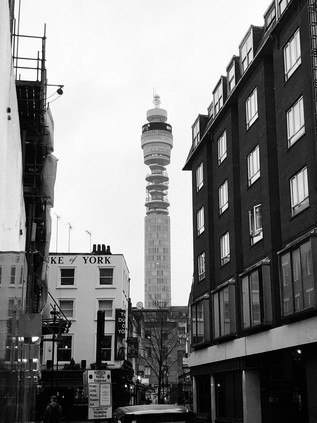
The final few miles of my journey passed in something of a blur: I'd walked this way in reverse around sixteen years ago, heading for the George Gissing conference at Senate House on foot. Back then it had felt like a slightly foolish undertaking, but I was accompanying a fellow delegate with a mortal fear of the Underground. As we padded west from the station along Wigmore Street contemplating the long walk ahead, I'd marvelled at this world hidden behind the retail excesses of Oxford Street. My earliest London experience had been a tentative walk out from Paddington which reached as far as Centre Point early one December morning over thirty years ago. It had seemed impossible and overwhelming, the swollen crowds of shoppers breaking like tsunamis on each road crossing and crushing dangerously around the entrances to Bond Street and Oxford Circus stations. And here, just a few yards away had been a comparative oasis. Figuring that Oxford Street would be living up to my original impressions again today I took this route again. This time though, I detoured into Welbeck Street to pay tribute to the elaborate concrete car park now threatened with demolition. Much of the architecture of this part of the West End is drab and carelessly hidden behind gaudy shopfronts, but the striking pattern of concrete shields which interlock to create this rather strange intruder is far from dull. It was though nearly impossible to get a good image: the pale concrete faded into the flat, featureless skies while passers-by nudged and hustled in their rush to get to the shops. I turned west again, towards what promised to be an unexpectedly glorious sunset despite the gloomy afternoon. A vista to the south opened as I crossed Great Cumberland Place, revealing the surprisingly tiny profile of Marble Arch offering a disappointing gateway to tourist London. I'd passed that way all those years ago in the press of the crowds and became determined to somehow understand the city beyond the facade. I wasn't sure I'd succeeded, but it had been a hell of a walk to try to find it. In the west, over the snarled traffic of Edgware Road the sky was now a swirl of orange and black. The long straight route of Watling Street led northwest in a trail of red taillights, heading out to further suburbs - some explored, some still little more than familiar names on the map. I was most definitely in the west now, as the stucco and faded grandeur of hotels around Hyde Park Square gradually ebbed into a little unknown village of bistros and bakeries near Sussex Place. After a day stuck indoors, the locals were tentatively coming out to chat and smoke at outdoor tables, wrapped up against the chilly evening. London felt benign and old here - the city of Patrick Hamilton with its myriad disappointments and hyperlocal dramas unfolding behind fogged-up windows.
I uttered a little gasp of recognition as suddenly the arc of Paddington Station's roofline appeared above the street. Without entirely intending to, I'd walked all the way back to where I'd started! Where I'd set out from this morning - but also where I'd started that tentative first walk into 'London' all that time ago. The Aberdeen Steakhouse on the corner was still trading, its illuminated sign and deep red upholstery casting a sanguine glow over the crossroads. It had all seemed so exotic back then: steak houses and bureaux de change, tiny cafés and foreign mini-markets. I hadn't guessed then that I'd see countless numbers of these little district shopping parades across the city - for me, in that moment of awestruck arrival this was London. I made my way into the station, shocked to have walked entirely across the city - it was never my intention, but it seemed fitting. This was an unravelling of memories: remediating recent excursions in the east, fading into the well-worn tracks of the city, and eventually arriving back at my point of departure in the once possibility-filled avenues of the west. I knew, as I sipped coffee and marked time above the platforms that it might be a long time before I was back here. I was tempted to capture the mundane scene in Brunel's terminus like some sort of moment of importance - but that's not my London and never has been. Instead I once again allowed the city to slip around me, watched people milling and regrouping under the glow of deceitful departure boards, studied shoppers grappling with the automatic check-outs in M&S and needing supervisors to authorise their travelling wine rations. London continued, as ever - despite all apocalyptic predictions. It will be doing the very same thing as you read this - crowds forming and dispersing, plots and dramas coalescing in greasy cafés, and very likely other over-serious would-be writers will be gazing down over station platforms, either starting or - hopefully temporarily - completing their journeys...
One thing I had learnt, the last person you should ask for a solution is the author. If he knew where he was going, he'd stop dead in his tracks.Landor's Tower, Iain Sinclair, 2002
You can find more images from the walk here.
Lost::MikeGTN
I've had a home on the web for more years than I care to remember, and a few kind souls persuade me it's worth persisting with keeping it updated. This current incarnation of the site is centred around the blog posts which began back in 1999 as 'the daylog' and continued through my travels and tribulations during the following years.
I don't get out and about nearly as much these days, but I do try to record significant events and trips for posterity. You may also have arrived here by following the trail to my former music blog Songs Heard On Fast Trains. That content is preserved here too.

